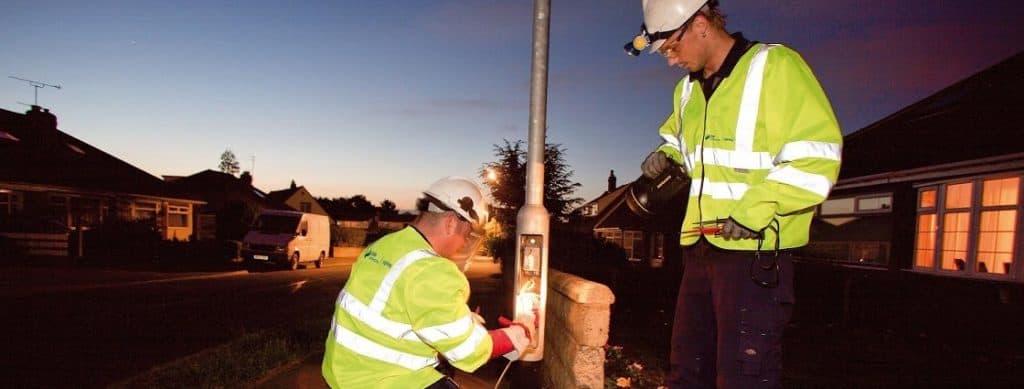
Arc flash clothing- PPE to protect workers

In the following article, we assess the types of Arc Flash risks and the prevention of those same risks through the implementation of effective Arc Flash Clothing & PPE for workers in the UK Highways & Street Lighting industry.
With guidance from the UK Health & Safety Executive’s HSG85, Engineering Recommendation G39/1 and the Highways Electrical Association (HEA), we provide advice on management procedures to facilitate a continued achievement of safe working practices.
The role of Risk Assessment Method Statements (RAMS) and Safe Systems Of Work (SSOW) are mentioned as key underpins to arc flash mitigation and worker protection.
In recognition of those dangers and working with ProGARM, the leading UK manufacturer of the Flame Resistant & Arc Flash Clothing, we show how together we ensure workers return home safe.
We hope to clear the current ambiguity of attitudes to the subject with some interesting statistics that in conclusion may or may not achieve that objective.
Let me know your thoughts later here or vote in our Poll below – so lets get started.
According to the UK Health & Safety Executive (HSE) most electrical accidents occur because people are working on or near equipment:
- Thought to be dead but which is live
- Known to be live but those involved do not have adequate training or appropriate equipment to prevent injury, or they have not taken adequate precautions
Arc flash can only occur on live cables, circuits or electrical equipment.
Arc Flash Defined
“Electrical arcing (sometimes called a ‘flashover’ or ‘arc flash’), perhaps as a result of a short circuit caused by unsafe working practices, can generate intense heat leading to deep-seated and slow-healing burns, even if it persists for a short time.
The intense ultraviolet radiation from an electric arc can also cause damage to the eyes.
Often those working with or near electricity do not appreciate the risk of serious injury and consequential damage to equipment that can arise from arcing. Arcing, overheating and, in some cases, electrical leakage currents can cause fire or explosion by igniting flammable materials.
“This can cause death, injury and considerable financial loss.”
Extract from HSG85 UK HSE Electricity At Work – Safe Working Practices.
The UK HSE is an independent regulator providing advice, guidance, news, tools, legislation and publications for work-related health, safety and illness issues.
♦ ARC FACT Electric arc causes an ionization of the air with arc flash temperatures generating a fireball reaching up to 35,000 degrees Fahrenheit. This is hotter than the surface of the sun.
Arc Flash – The Risks
Street Lighting Electrical Cable Dangers
Injuries are usually caused by the explosive effects of arcing current, and by any associated fire or flames that may result when a live cable is penetrated by a sharp object such as the point of a digging tool.
Excavating around public utilities always carries the potential for those utilities to be damaged and for those involved to be seriously injured.
In particular electrical cables carrying low voltage domestic electricity can cause serious burns.
It is therefore important that all those involved in excavation work comply with safe digging practices to ensure the safety of themselves and anyone else who may be close by.
Further reading:
HSG47 UK HSE Avoiding Danger From Underground Services
Street lighting engineers and operatives are exposed to arc flash risks if correct digging procedures are not followed while excavating underground electricity cables – operatives have suffered arc flash burns when digging with a hammer drill directly above an identified live buried cable.
Upon making contact with a 415v street lighting cable, ‘arc flash’ occurred resulting in burns to the wrist and elbow and a visit to the hospital A&E – this could have been much worse.
Never dig directly over an identified live buried service. Powered hand tools used close to live cables are likely to represent the greatest risk of injury.
Arc Flash Clothing
In the street lighting industry arc clothing should be rated according to IEC61482 – under test method IEC6182-1-1 garments are tested and then categorized into 5 levels of protection as per the chart below. Typically Category 2 arc flash clothing covers workers for the majority of tasks however this should be dependent and based on risk assessment of the job in hand.
ProGARM recommend worker should be protected from arc flash by a helmet with full visor, insulating gloves and garments such as arc flash polo shirt, arc flash trousers and coveralls with Category 2 flash protection.
Hazard Risk Categories According To IEC 61482
Incident Energy Level
(caVcm2) Hazard Risk
Category PPE Type Arc Flash Clothing & PPE Details (Basic Examples)
0 – 3.9 0 0 1 full FR/ARC layers (covering all body), polycarbonate safety spectacles, lightweight cotton gloves.
4 – 7.9 1 1 1 layer flame retardant (FR) work wear, helmet, polycarbonate safety spectacles, lightweight FR gloves.
8 – 24.9 2 2 As above but with 2 layer FR outer work wear that has wrist closures, and a full face polycarbonate visor. A FR single-layer balaclava may also be worn to protect the face.
25 – 39.9 3 3 3 layer FR outer work wear and FR shirt, a full-face hood or visor with safety spectacles underneath, chrome leather gauntlets.
40+ 4 4 Typically 4 layer FR outer work wear (as illustration), FR and electrically insulated footwear and suitable FR material spats to close off the ankle area, FR gloves or chrome leather gauntlets, a hood constructed from a triple layer of FR material with a sewn-in polycarbonate face shield with a minimum of 2 panels of suitable thickness with one coated with a gold film for UV protection.
♦ ARC FACT The arc blast can rupture ear drums and project molten metal into the face and lungs without adequate PPE protection.
G39 Working In the Vicinity Of DNO / IDnO Electrical Equipment
Engineering Recommendation G39 is a Model Code of Practice covering Electrical Safety in the Planning, Installation, Commissioning and Maintenance of Public Lighting and Street Furniture.
G39 scope covers low voltage electrical installations (up to 1000V), the associated inherent risks, hazards and requirement for implementation of thorough and proper PPE to protect workers against electrical injuries.
Under obligation of law the employee must provide a Safe Systems of Work (SSOW) to enable safe working where hazardous work processes are present, for instance the risk of arc flash when working in the vicinity of live conductors in a cable trench during jointing of utility cables.
G39 does not mandate PPE requirements – this is the absolute responsibility of the employer (or if you’re the employer, the employee and vice versa).
However, leading industry bodies including the Highways Electrical Association would always recommend arc flash clothing and protective PPE where this is available.
Perilous Contradictions, Mixed Messages & A Mexican Stand-Off
Despite this a recent study by ProGARM in conjunction with the British Safety Industry Federation (BSIF) revealed a shocking level of widespread industry ignorance with 25% of employers attributing the sole responsibility to the employee, not the employer, to self-protect against arc flash.
Worryingly, 50% expect the employee to also self-educate through personal research.
Perverse as it may sound, try Googling “how to save my life against arc flash”. Over 43 million search results to wade through – some contradictory, some misleading.
This employer-employee confrontation across the knowledge gap is exacerbated by government passivity, resulting in an unresolved tension with workers endangered daily due to lack of understanding and ultimately absence of UK legislation – until legal action is taken, as in the USA, the stand-off prevails and the risk pervades.
Read the article in full, here.
Read Thorne & Derrick International previous post, here.
External URL: https://www.powerandcables.com/arc-flash-clothing-ppe/
By Thorne & Derrick International
1710 Views



